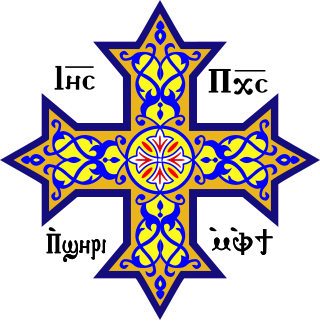The Berlin Codex, given the accession number Papyrus Berolinensis 8502, is a Coptic manuscript from the 5th century CE, unearthed in Akhmim, Egypt. In Cairo, in January 1896, Carl Reinhardt bought the codex, which had been recently discovered, wrapped in feathers, in a niche in a wall at a Christian burial site. It was a papyrus bound book, dating to early 5th century that was written in Sahidic dialect of Coptic, which was in common use in Egypt during that time.

The Dishna Papers, also often known as the Bodmer Papyri, are a group of twenty-two papyri discovered in Dishna, Egypt in 1952. Later, they were purchased by Martin Bodmer and deposited at the Bodmer Library in Switzerland. The papyri contain segments from the Old and New Testaments, early Christian literature, Homer, and Menander. The oldest, P66 dates to c. 200 AD. Most of the papyri are kept at the Bodmer Library, in Cologny, Switzerland outside Geneva.

There have been many Coptic versions of the Bible, including some of the earliest translations into any language. Several different versions were made in the ancient world, with different editions of the Old and New Testament in five of the dialects of Coptic: Bohairic (northern), Fayyumic, Sahidic (southern), Akhmimic and Mesokemic (middle). Biblical books were translated from the Alexandrian Greek version.

Coptic literature is the body of writings in the Coptic language of Egypt, the last stage of the indigenous Egyptian language. It is written in the Coptic alphabet. The study of the Coptic language and literature is called Coptology.
Codex Bodmer XIX is a Coptic uncial manuscript of the four Gospels, dated palaeographically to the 4th or 5th century. It contains the text of the Gospel of Matthew 14:28-28:20; Epistle to the Romans 1:1-2:3. It is written in the Sahidic dialect of the Coptic language.
Codex Bodmer III, is a Coptic uncial manuscript of the fourth Gospel, and the first four chapters of Genesis, dated palaeographically to the 4th century. It contains the text of the Gospel of John with some lacunae. It is written in an early Bohairic dialect of Coptic language.
Huntington 17 is a bilingual Bohairic-Arabic, uncial manuscript of the New Testament, on a paper. It is dated by a colophon to the year 1174. It is the oldest manuscript with complete text of the four Gospels in Bohairic.
Huntington 20 is a Bohairic-Greek, uncial manuscript of the New Testament, on paper. Palaeographically it has been assigned to the 13th century.
Codex Marshall Or. 5, is a Bohairic-Greek, uncial manuscript of the New Testament, on a paper. Palaeographically it has been assigned to the 14th century.
Codex Marshall Or. 6, is a Bohairic, uncial manuscript of the New Testament, on a paper. Palaeographically it has been assigned to the 16th century.
George William Horner (1849–1930) was a British biblical scholar, an editor of the text of the New Testament in the dialects of the Coptic language.

Codex Oriental Ms. 424, designated by siglum A1 (Horner), t (de Lagarde [= Boetticher]), is written in two languages Bohairic-Arabic, uncial manuscript of the New Testament, on paper. It is dated by a colophon to the year 1308. Many leaves of the codex were lost.
Oriental MS 425, is a bilinguical Bohairic-Arabic, uncial manuscript of the New Testament, on paper, now in the British Library in London. It is dated by a colophon to the year 1308. The manuscript is lacunose.
Oriental MS 426, bilinguical Bohairic-Arabic, uncial manuscript of the New Testament, on paper, now in the British Library in London. It is dated to the 13th century. The manuscript is lacunose.
Oriental MS 1001, Bohairic, uncial manuscript of the New Testament, on paper. Palaeographically it has been assigned to the 12th century. Several leaves of the codex were lost. Horner designated the manuscript by siglum E2.
Add MS 5995, bilingual Bohairic-Arabic, uncial manuscript of the New Testament, on paper. It is dated to the fourteenth century. The manuscript has complex contents.
Oriental MS 1001, Bohairic-Arabic, uncial manuscript of the New Testament, on paper. It is dated to the year 1663. Horner designated the manuscript by siglum H3.
Codex Copticus Tischendorfianus I is a Coptic uncial manuscript of the four Gospels, dated palaeographically to the 10th or 11th century. Originally it contained the text of the four Gospels. It is written in Sahidic dialect of Coptic language. It is classified on the list of Coptic manuscripts of the New Testament on the position sa 181. The manuscript has survived in a fragmentary condition.

Early translations of the New Testament – translations of the New Testament created in the 1st millennium. Among them, the ancient translations are highly regarded. They play a crucial role in modern criticism of New Testament's text. These translations reached the hands of scholars in copies and also underwent changes, but the subsequent history of their text was independent of the Greek text-type and are therefore helpful in reconstructing it. Three of them – Syriac, Latin, Coptic – date from the late 2nd century and are older than the surviving full Greek manuscripts of the New Testament. They were written before the first revisions of the Greek New Testament and are therefore the most highly regarded. They are obligatorily cited in all critical editions of the Greek text-type. Translations produced after 300 are already dependent on the reviews, but are nevertheless important and are generally cited in the critical apparatus. The Gothic and Slavic translations are rarely cited in critical editions. Omitted are those of the translations of the first millennium that were not translated directly from the Greek original, but based on another translation.




